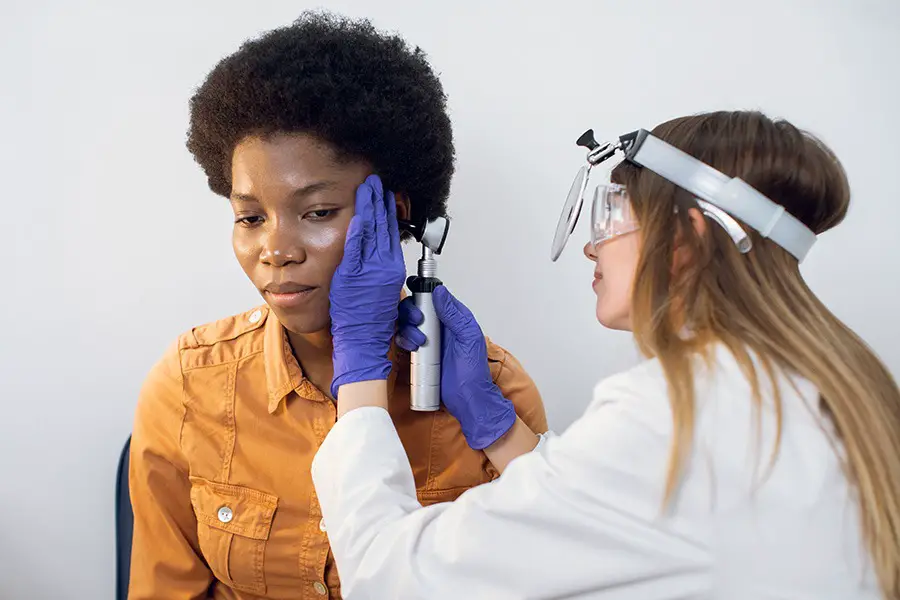Introduction
Our acoustic sensory system is a remarkable natural phenomenon, providing us the bridge to a world filled with sounds. From the gentle whispers of wind to the powerful climax of an orchestra, our auditory faculties define our interaction with life. Nevertheless, for numerous adults, this interaction is hampered due to a condition named sensorineural hearing loss. As the predominant form of hearing impairment, it’s a complex and often misinterpreted disorder. This article will explore the intricate realm of sensorineural hearing loss, highlighting groundbreaking research, promising treatment avenues, and the key contributors to this condition. Our goal is to enlighten and educate, creating a valuable resource for adults affected by sensorineural hearing loss.
Sound Oasis® Bluetooth® Tinnitus Sound Therapy System®
Discover the ultimate solution for managing tinnitus with Play. This innovative device offers you 20 meticulously crafted built-in sounds, specifically recommended by esteemed audiologists worldwide. Dive into a world of soothing melodies and find respite from the challenges of tinnitus.
Immerse yourself in an audio oasis with Play’s integrated Bluetooth technology. Stream your favorite sounds or music wirelessly with a Bluetooth range of up to 30 feet (10 meters). Experience the freedom of wireless connectivity as you create your own personal sanctuary of sound.
Enhance your relaxation journey with the Sound Oasis Professional Tinnitus Frequency App, included with Play. Immerse yourself in a diverse range of calming sounds meticulously designed to alleviate tinnitus symptoms. Unwind, find serenity, and embark on a path towards improved sleep with this powerful companion.
Enjoy uninterrupted tranquility with Play’s versatile power options. Utilize the built-in rechargeable battery, providing you with 4-5 hours of continuous use per charge. Alternatively, keep Play plugged in using the included charging cable for extended periods of blissful sound. Dive into the soothing world of Play and experience the transformative benefits it brings to managing tinnitus.
Heading into Uncharted Territory: The Search for a Sensorineural Hearing Loss Cure
The pursuit of a cure for sensorineural hearing loss is unending, with dedicated scientists globally contributing their expertise to this mission. Present research is wide-ranging, investigating areas from genetic therapy to biological engineering solutions. For instance, an optimistic field of study focuses on the regeneration of impaired hair cells in the cochlea—the part of the inner ear that converts sound vibrations into neural signals. Damage to these cells results in sensorineural hearing loss. Recent breakthroughs, however, hint at the possibility of encouraging these cells’ regeneration, which could potentially reverse sensorineural hearing loss effects.
The Potential of Stem Cells to Counter Sensorineural Hearing Loss: Recent Studies
Capitalizing on the concept of cell regeneration, stem cell therapy emerges as a hopeful path in the combat against sensorineural hearing loss. Known for their transformative capacity into various cell types, stem cells present potential in regenerating impaired hair cells in the inner ear. Early studies have reported encouraging outcomes. For instance, a study featured in the Journal of the Association for Research in Otolaryngology showed that transplanted stem cells could successfully grow to mimic native hair cells in mice, suggesting possible implications in human therapy.
The Ear’s Intricate Blueprint: Unraveling Its Inner Mechanisms and Sensorineural Hearing Loss
For a deeper understanding of sensorineural hearing loss, we need a basic comprehension of the ear’s complex structure. The ear is divided into three primary parts: the outer, middle, and inner ear. The outer ear captures sound waves, steering them into the ear canal. These sound waves then reach the middle ear, setting the eardrum in motion. This vibration is then transferred to the ossicles, a trio of minuscule bones that amplify the sound and direct it towards the inner ear.
Residing within the inner ear is a spiral-shaped structure known as the cochlea, which is filled with fluid and lined with numerous tiny hair cells. The movement of these hair cells in response to the fluid’s vibrations generates electrical signals, which are then relayed to the brain via the auditory nerve, allowing us to decode the sounds. Sensorineural hearing loss primarily stems from damage to these hair cells or the auditory nerve itself. Grasping this mechanism is vital, as it sets the stage for potential treatment strategies targeting these precise structures.
QUIZ - SYMPTOMS OF HEARING LOSS
Investigating the Causes of Sensorineural Hearing Loss in Children
Sensorineural hearing loss doesn’t restrict itself to adults; it significantly influences the lives of children as well. Multiple factors contribute to this condition in the younger populace. Genetic influences often play a crucial role. Specific genetic variations can result in hearing loss at birth or progressive hearing loss as the child matures. Infections during pregnancy, such as rubella or cytomegalovirus, can also lead to sensorineural hearing loss in the offspring.
In addition, premature birth is another noteworthy factor, with preterm infants exhibiting a heightened risk of sensorineural hearing loss. Noise exposure, although less prevalent in children compared to adults, can also lead to this condition. It’s essential to spread awareness about these causative factors to promote early detection and intervention, potentially enhancing the quality of life for children afflicted by sensorineural hearing loss.
Noise-Induced Sensorineural Hearing Loss: A Closer Examination
One particular cause of sensorineural hearing loss that deserves further scrutiny is noise-induced hearing loss (NIHL). Exposure to high noise levels over an extended duration or even a single traumatic event can cause permanent impairment to the inner ear, resulting in sensorineural hearing loss. Occupational noise, leisure activities, and environmental factors all add to the risk of developing NIHL.
Comprehending the mechanisms of NIHL enables individuals to take proactive protective measures. The intensity of sound is quantified in decibels (dB), and prolonged exposure to sounds over 85 dB can be harmful. For instance, laboring in a construction site, attending high-decibel concerts, or using loud headphones for extended durations can all heighten the risk of NIHL.
Prevention plays a key role when it comes to noise-induced sensorineural hearing loss. Adopting strategies such as using hearing protection devices (like earplugs or earmuffs) in noisy environments, maintaining safe listening volumes during leisure activities, and raising awareness about the importance of auditory conservation can significantly mitigate the incidence of NIHL.
Conclusion
In this extensive examination of sensorineural hearing loss, we’ve delved into pioneering research endeavors, scrutinized prospective cures, and the potential of stem cell therapy. We’ve traversed the complex anatomy of the ear, offering insights into the cellular mechanisms behind sensorineural hearing loss. Furthermore, we’ve illuminated the causes of sensorineural hearing loss in children, accentuating genetic factors and the implications of noise exposure. Lastly, we’ve focused on noise-induced hearing loss and the significance of preventive measures.
While sensorineural hearing loss presents unique difficulties, the leaps in research and technological advancements offer hope for improved treatment methods and interventions. By increasing awareness, fostering comprehension, and advocating for auditory health, we can enable individuals suffering from sensorineural hearing loss to lead enriched lives. Remember, early identification, timely interventions, and proactive auditory preservation are crucial in the path towards improved hearing and life quality.
Through this comprehensive exploration of sensorineural hearing loss, we have delved into state-of-the-art research initiatives, examining potential solutions and the potential of stem cell therapy. We have dissected the complex anatomy of the ear, providing an understanding of how sensorineural hearing loss occurs on a cellular level. We have also highlighted the causes of sensorineural hearing loss in children, emphasizing genetic factors and the influence of noise exposure. Finally, we have illuminated the topic of noise-induced hearing loss and the critical role of preventative measures.
Sensorineural hearing loss presents unique hurdles, but with strides in research and technological developments, there is hope for enhanced treatments and interventions. By fostering awareness, nurturing understanding, and championing for auditory health, we can equip individuals with sensorineural hearing loss to lead fulfilling lives. Bear in mind that early detection, timely interventions, and proactive auditory preservation are fundamental in the journey towards improved hearing and life quality.

Decoding Silence: An Analytical View on the Advances in Conductive Hearing Loss Research and Treatment
This analytical article sheds light on conductive hearing loss, offering an in-depth exploration of its genetic factors, treatment advances, and promising experimental therapies.

Embracing the Melody of Life: Navigating the Journey with Conductive Hearing Loss
A blog post delving into the experiences and challenges of living with conductive hearing loss, discussing its impact on everyday life, social interactions, mental health, and the potential benefits of hearing aids and cochlear implants.





